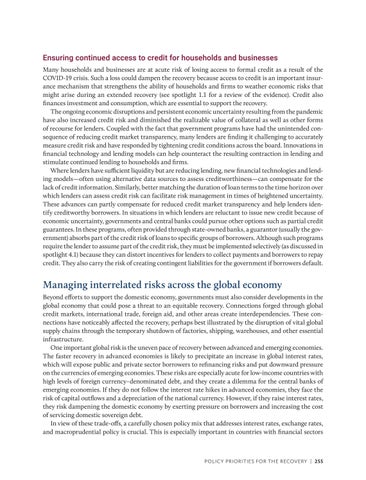Ensuring continued access to credit for households and businesses Many households and businesses are at acute risk of losing access to formal credit as a result of the COVID-19 crisis. Such a loss could dampen the recovery because access to credit is an important insurance mechanism that strengthens the ability of households and firms to weather economic risks that might arise during an extended recovery (see spotlight 1.1 for a review of the evidence). Credit also finances investment and consumption, which are essential to support the recovery. The ongoing economic disruptions and persistent economic uncertainty resulting from the pandemic have also increased credit risk and diminished the realizable value of collateral as well as other forms of recourse for lenders. Coupled with the fact that government programs have had the unintended consequence of reducing credit market transparency, many lenders are finding it challenging to accurately measure credit risk and have responded by tightening credit conditions across the board. Innovations in financial technology and lending models can help counteract the resulting contraction in lending and stimulate continued lending to households and firms. Where lenders have sufficient liquidity but are reducing lending, new financial technologies and lending models—often using alternative data sources to assess creditworthiness—can compensate for the lack of credit information. Similarly, better matching the duration of loan terms to the time horizon over which lenders can assess credit risk can facilitate risk management in times of heightened uncertainty. These advances can partly compensate for reduced credit market transparency and help lenders identify creditworthy borrowers. In situations in which lenders are reluctant to issue new credit because of economic uncertainty, governments and central banks could pursue other options such as partial credit guarantees. In these programs, often provided through state-owned banks, a guarantor (usually the government) absorbs part of the credit risk of loans to specific groups of borrowers. Although such programs require the lender to assume part of the credit risk, they must be implemented selectively (as discussed in spotlight 4.1) because they can distort incentives for lenders to collect payments and borrowers to repay credit. They also carry the risk of creating contingent liabilities for the government if borrowers default.
Managing interrelated risks across the global economy Beyond efforts to support the domestic economy, governments must also consider developments in the global economy that could pose a threat to an equitable recovery. Connections forged through global credit markets, international trade, foreign aid, and other areas create interdependencies. These connections have noticeably affected the recovery, perhaps best illustrated by the disruption of vital global supply chains through the temporary shutdown of factories, shipping, warehouses, and other essential infrastructure. One important global risk is the uneven pace of recovery between advanced and emerging economies. The faster recovery in advanced economies is likely to precipitate an increase in global interest rates, which will expose public and private sector borrowers to refinancing risks and put downward pressure on the currencies of emerging economies. These risks are especially acute for low-income countries with high levels of foreign currency–denominated debt, and they create a dilemma for the central banks of emerging economies. If they do not follow the interest rate hikes in advanced economies, they face the risk of capital outflows and a depreciation of the national currency. However, if they raise interest rates, they risk dampening the domestic economy by exerting pressure on borrowers and increasing the cost of servicing domestic sovereign debt. In view of these trade-offs, a carefully chosen policy mix that addresses interest rates, exchange rates, and macroprudential policy is crucial. This is especially important in countries with financial sectors
POLICY PRIORITIES FOR THE RECOVERY | 255

